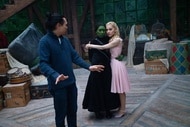Create a free profile to get unlimited access to exclusive videos, sweepstakes, and more!
How They Literally Built A Complete 1800s Ship - And a Half - To Film Last Voyage of the Demeter
The Last Voyage of the Demeter sets sail on the big screen Friday, Aug. 11.

For the last 44 years, Hollywood has been chasing the haunted house high of Ridley Scott's Alien.
The premise of a tight-knit group of relatable characters stalked by a horrific beast throughout a limited backdrop is pretty simple in theory, yet incredibly difficult in execution. Director André Øvredal (The Autopsy of Jane Doe, Scary Stories to Tell in the Dark) will attempt to recreate that old Nostromo magic this coming Friday — Aug. 11 — with The Last Voyage of the Demeter.
RELATED: The Modern Horror Legend Who Plays Dracula in André Øvredal's The Last Voyage of the Demeter
Drawing inspiration from a single chapter in Bram Stoker's Dracula novel, the film takes place aboard the titular merchant vessel, circa 1897, which makes the oldest vampire blunder in the book by unknowingly inviting an undead bloodsucker aboard. Universal has released an interactive walkthrough of the Demeter, and you can explore the ship here.
Thirsting for fresh blood, the Transylvanian ghoul (played here by Javier "Javi" Botet) takes the form of an emaciated bat-monster and brutally slaughters the crew once the sun dips below the horizon. There is no escape or refuge from Drac's neck-biting rampage...unless this band of salty sea dogs would rather jump overboard and take their chances with Davy Jones.
The Last Voyage of the Demeter director talks vision for the titular ship
Speaking with Universal Pictures about the horror undertaking for the studio's electronic press materials, Øvredal explained that he wanted the Demeter itself to "be very dull in a way." Not to bore audiences, of course, but to ground the narrative in some basis of reality — and the relative comfort of the unordinary — before the supernatural element comes into play.
"It had to be like a cargo ship — not a beautiful, big [vessel]," he said. "It needed to be a very simple ship."
At the same time, the boat required "a lot of space" in order to create "spatial tension and ... unreliable environments that the actors could be scared in." Immersing the cast within the world of the movie and making them wonder what corner Dracula might be lurking around, was the key to unlocking a genuine sense of blossoming terror.
"We needed to make it huge because they’re supposed to walk around on the ship, day and night, and discover new things," the filmmaker emphasized. "So if the ship was too small, we didn’t have enough space to tell the complex story that we’re telling."
RELATED: Is The Last Voyage of The Demeter Based on A True Story? Real History Behind Dracula Film
He later continued: "I also wanted the ship to feel very grounded and gritty and dirty and real. So we had to go over the whole ship and it was built with old material [by] so many people who were sanding it down and making it look old and used. We were going over it again and again to make sure that it just really felt grounded down from 50 years of use at sea."
In a separate interview facilitated before the SAG-AFTRA strike took effect last month, cast member Liam Cunningham (Captain Eliot) affectionally characterized the builders behind the Demeter sets as "these wonderful shipping nerds who love these old boats."
Where was The Last Voyage of the Demeter filmed?
The exterior (complete with deck and working sails) was constructed at Malta Film Studios, which "boasts one indoor tank and two large exterior water tanks situated along the Mediterranean coast," reads the official production notes.
Measuring 214 feet long and 38 feet wide, the set was the "biggest ship that has ever been in that tank in Malta and ... that includes all of Ridley Scott’s movies that were also shot there," Øvredal said, referring to the studio's horizon-facing tank. In addition, the crew built a "half ship" for the opening scenes where the Demeter loads its mysterious cargo in the port of Varna before setting off for England.
The interiors, on the other hand, were shot at Studio Babelsberg AG in Germany. Fittingly enough, it's the same studio where the first film adaptation of Dracula — Nosferatu (a remake is currently in the works from Robert Eggers) — kicked off production a century before.
"We needed it to feel like a labyrinth inside with all [the] nooks and crannies and dark spots and long hallways," Øvredal said, adding that he and production designer Edward Thomas (Escape Room, Monster Hunter) focused a lot of their efforts on the cargo hold, from which Dracula's rampage emanates. "That had to be graphic and impressive and kind of frightening as a place to be."
A number of indoor sets were built atop a gimbal that simulated the rocking of the ocean. This worked a little too well, according to leading cast member Corey Hawkins (Clemens), who recalled how a number of actors became genuinely "seasick." He describes it as an incredibly "strange" sensation in the production notes (also collated before the strike).
RELATED: The Last Voyage of the Demeter Images and Featurette Reveal "Scariest Depiction of Dracula Ever"
When does The Last Voyage of the Demeter open in theaters?
Written by Bragi Schut Jr. (Escape Room) and Zak Olkewicz (Bullet Train), The Last Voyage of the Demeter sets sail on the big screen this coming Friday — Aug. 11. Demeter is rated R for bloody violence. Click here to sink your fangs into some tickets!
Want to satisfy your craving for undead fare in the meantime? Renfield and Vampire Academy are now streaming on Peacock. Looking ahead, SYFY's Reginald the Vampire is set to return later this year for a second season.
**The quotes from Cunninghman and Hawkins were given to Universal Pictures before the actors' strike.**



























